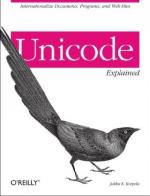|
This section contains 467 words (approx. 2 pages at 300 words per page) |

|
Unicode is a standard for the representation of characters as integers. Another means of character representation, the American Standard Code for Information Interchange (ASCII), is a more commonly used form of character representation. Although ASCII uses only eight bits for each character, Unicode uses 16 bits to represent each character. This means that Unicode is capable of representing more than 65,000 unique characters. By comparison, ASCII's capacity is only 128 characters. For the English language and Western-European languages, the full character capability of Unicode is not utilized. However, languages such as Greek, Chinese and Japanese cannot be fully represented without the power of Unicode.
The Unicode standard was created in 1991 by a team of computer professionals, linguists and scholars. Since the first version (1.0) several versions have been released (1.1, 2.0, 2.1, and 3.0). Version 4.0 of Unicode is expected within the next several years.
In its inception, provision was made in Unicode for every character, punctuation...
|
This section contains 467 words (approx. 2 pages at 300 words per page) |

|


